

Dedication Page for Academic Papers [11 Examples]
The dedication section is where the writer expresses gratitude or others, normally those who have inspired or assisted them in their research and writing. It is usually the shortest page of an academic paper.
The most important thing to remember is that there is NO exact formula for writing a perfect dedication. Dedication is one of the most personal parts of your writing, and you are free to write it however you like.
In this post, we will include examples of dedication for theses, dissertations, research papers and college projects.
- How to Write a Dedication for a Thesis or Dissertation?
- Is Acknowledgement and Dedication the Same?
Who to include in the dedication section?
You can choose whomever you want. A dedication section is generally short and focuses on a single person (or specific group of people). It is usually a personal matter to have a dedication section, rather than a professional one.
Dedication Examples for Thesis or Dissertation
Most of the dedications in the thesis or dissertation are dedicated to family and friends.
You can express your feelings on why you want to dedicate your writings to these people specifically in this section.
Here are some of the examples which you can use as an example for writing your dedication for your thesis or dissertation.
Dedication for Dissertation/Thesis: Example #1
Dedication for dissertation/thesis: example #2, dedication for dissertation/thesis: example #3, dedication for dissertation/thesis: example #4, dedication for dissertation/thesis: example #5, dedication for dissertation: example #6, dedication examples for research paper.
Here are some examples of dedication written for research papers.
Dedication for Research Paper: Example #1
DEDICATION I dedicate this research paper to my lovely wife Laura, and my two daughters Dana, and Kareem. To all my family, the symbol of love and giving, and my friends who encourage and support me.
Dedication for Research Paper: Example #2
DEDICATION This research paper is dedicated to my dear father, who has been nicely my supporter until my research was fully finished, and my beloved mother who, for months past, has encouraged me attentively with her fullest and truest attention to accomplish my work with truthful self-confidence.
Dedication for Research Paper: Example #3
DEDICATION This research is dedicated to all the members of group 5 class 21/2012 for their sacrifice and cooperation in researching this paper. Our appreciation goes to MRS KANGETHE and MR KARIUKI for their guidance in the preparation of the final document and to our colleagues in the SMC 21/2012 for their support.
Dedication for College Projects
Here are two examples of dedication for college projects:
Dedication for College Project: Example #1
Dedication for college projects: example #2, other popular acknowledgement examples.
For work or business Acknowledgement Receipt of Payment [4 Examples] Acknowledging Receipt of Documents: A Quick Guide with Examples Acknowledgement for Presentation [9 Examples] Acknowledgement for Job Offer [3 Examples] Acknowledgement for Business Plan [4 Examples] Acknowledgement for Work Immersion [5 Examples] Acknowledgement of Receipt of Appraisal [3 Examples] Acknowledegment of Debt [5 Examples] Resignation Acknowledgement for Employers [5 Examples]
Academic Acknowledgement for Research Paper [5 Examples] Acknowledgement for Internship Report [5 Examples] Acknowledgement for Thesis and Dissertation [15 Examples] Acknowledgement for Portfolio [5 Examples] Acknowledgement for Case Study [4 Examples] Acknowledgement for Academic Research Paper [5 Examples] Acknowledgement for College/School Assignment [5 Examples] Acknowledgemet to God in Reports [5 Examples]
Others Acknowledgement to Funeral Attendees [5 Examples] Funeral Acknowledgement Templates (for Newspapers and Websites) Common Website Disclaimers to Protect Your Online Business Notary Acknowledgement [5 Examples]
How-to Guides on Academic Writing and Others
Most popular How to Write an Acknowledgement: The Complete Guide for Students How to Write an Acknowledgement for College Project? How to Write a Dedication Page for a Thesis or Dissertation? More on acknowledgements How to Write Acknowledgment for a Dissertation or a Thesis? Is Acknowledgement and Dedication the Same? Thesis or Dissertation How to Write a Master’s Thesis: The Ultimate Guide How to Write a Thesis Proposal? How to Write an Abstract for a Thesis? How to Write a Preface for a Thesis? Others How to Write an Introduction for a Research Paper? 7 Real Research Paper Examples to Get You Started How to Write Cover Letter for an Internship Program? How to Write an Internship Acceptance Letter? How to Write a Leave Application? For Schools and the Workplace How to Write a Resignation Letter?
Introduction to Academic Writing
By O.P. Jindal Global University Duration: 16-hour Cost: FREE Gain an in-depth understanding of reading and writing as essential skills to conduct robust and critical research for your writing.
Writing in English at University
By Lund University Duration: 24-hour Cost: FREE Learn how to structure your text and arguments, quote sources, and incorporate editing and proofreading in your academic writing.
Academic English: Writing Specialization
By the University of California, Irvine Duration: 6 months Cost: Free 7-day trial, USD39 per month The skills taught in this Specialization will empower you to succeed in any college-level course or professional field. You’ll learn to conduct rigorous academic research and to express your ideas clearly in an academic format. Share your Course Certificates in your LinkedIn profile, on printed resumes, CVs, or other documents.

Thank you so much
U are turely the best
Very beneficial example! I learned a lot.
Thanks a milli for the knowledge shared. Thumbs up!!
helpful by a research student
Excellent way of describing, and good paragraph to obtain data regarding my presentation subject, which i am going to convey in university.
I appreciate your work man, thanks so much
Leave a Comment Cancel Reply
Your email address will not be published. Required fields are marked *
Save my name, email, and website in this browser for the next time I comment.


- Mardigian Library
- Subject Guides
Formatting Your Thesis or Dissertation with Microsoft Word
- Dedication, Acknowledgements, & Preface
- Introduction
- Copyright Page
- Headings and Subheadings
- Citations and Bibliography
- Page Numbers
- Tables and Figures
- Rotated (Landscape) Pages
- Table of Contents
- Lists of Tables and Figures
- List of Abbreviations
- Some Things to Watch For
- PDF with Embedded Fonts
Dedication, acknowledgements, & preface
Dedication, Acknowledgements, and Preface sections are all optional pages. But, what is the difference between these three?
Dedication — A personal tribute to someone or a group of people. Example: "To my parents."
Acknowledgements — A professional tribute to a person or people who helped you with the thesis. Example: "I wish to thank my thesis advisor for the hours of help in the lab making sure the experiments were set up properly and guiding me through the thesis process."
Preface ( sometimes confused with Foreward or Prologue ) — A very rarely included section that details why you are qualified to write about your topic of your thesis or why you became interested in the topic (for example, an anecdote about a childhood incident that led you to become interested in the topic). Do not confuse this with the literature review; this is more of a personal story.
The video below gives more examples of what can be included in these sections. Note: If your dedication is short (like "To my parents"), you may choose not to include the "Dedication" heading at the top of the page. A demonstration of how to format the dedication page this way is shown below.
- << Previous: Copyright Page
- Next: Headings and Subheadings >>
- Last Updated: Mar 21, 2024 2:35 PM
- URL: https://guides.umd.umich.edu/Word_for_Theses
Call us at 313-593-5559
Chat with us
Text us: 313-486-5399
Email us your question

- 4901 Evergreen Road Dearborn, MI 48128, USA
- Phone: 313-593-5000
- Maps & Directions
- M+Google Mail
- Emergency Information
- UM-Dearborn Connect
- Wolverine Access

- Langson Library
- Science Library
- Grunigen Medical Library
- Law Library
- Connect From Off-Campus
- Accessibility
- Gateway Study Center

Email this link
Thesis / dissertation formatting manual (2024).
- Filing Fees and Student Status
- Submission Process Overview
- Electronic Thesis Submission
- Paper Thesis Submission
- Formatting Overview
- Fonts/Typeface
- Pagination, Margins, Spacing
- Paper Thesis Formatting
- Preliminary Pages Overview
- Copyright Page
Dedication Page
- Table of Contents
- List of Figures (etc.)
- Acknowledgements
- Text and References Overview
- Figures and Illustrations
- Using Your Own Previously Published Materials
- Using Copyrighted Materials by Another Author
- Open Access and Embargoes
- Copyright and Creative Commons
- Ordering Print (Bound) Copies
- Tutorials and Assistance
- FAQ This link opens in a new window
The Dedication Page is optional. If you choose to include a Dedication Page, please ensure that:
- You are using the same font as in the rest of your manuscript.
- No images are included.
- Page number ii appears centered at the bottom of the page.
Please note that the Dedication Page is different from the Acknowledgements Page.
Dedication Page Example
Here is an example of a dedication page from the template:

- << Previous: Copyright Page
- Next: Table of Contents >>
- Last Updated: Feb 20, 2024 2:09 PM
- URL: https://guides.lib.uci.edu/gradmanual
Off-campus? Please use the Software VPN and choose the group UCIFull to access licensed content. For more information, please Click here
Software VPN is not available for guests, so they may not have access to some content when connecting from off-campus.
How to Write a Dedication
#scribendiinc
And the dedication goes to…
When you have finally completed the gruelling yet wonderful process of writing a book, short story , dissertation, etc., you are then faced with the difficult decision of dedicating this source of all your hard work to someone special. Here are some helpful tips to ease your anxiety and assist you in writing a dedication page.
Picking a person
The most difficult part of writing this piece of front matter is choosing who you would like to dedicate your work to. Some writers may find it to be the most difficult part of the whole process. When choosing who to write your dedication for, think about the process you just went through and who helped you get through it. This could include a variety of people, including a parent, sibling, or other family member, a spouse or partner, a friend, a supervisor, a colleague, or even a pet. This is a very personal choice and there is no wrong decision.
Naming names
After you have decided who you will write your dedication for, you must decide how you are going to identify them. This will be based on your own personal preference and what is appropriate, according to your relationship with that person. The identification could vary from formal to informal.
On the formal end of the spectrum, your dedication could be addressed to Dr. So and So, Mr. X, or even Mother and Father. In between formal and informal, there are options like Mom, Dad, My sister, My friend, a person’s first and last name (no title), etc. On the informal side, you could use the first name or nickname of someone you know.
Reason for the dedication
The next component in writing your dedication is explaining why you chose this person. Many authors provide a reason for their dedication selections. As with the whole dedication process, this is an extremely personal and subjective decision. The dedication could simply be: "For my mom"; others may choose to explain their decision: "For my mom; without her I would not be here." You may want to write a funny anecdote about the person, an experience you shared, or even a private joke shared only by the two of you. As seen in our example dedication page, there are many types of dedications, each with it's own style. Your reason is completely dependent on your personality and your relationship with the person to whom you are dedicating your work.
Addressing the dedication
There are many ways you can address your dedication. You could write, "I dedicate this book to …", "This is dedicated to …", "To: …", "For: …", or simply just start writing your dedication without any formal address. It should be on its own page so everyone will get the hint that it is a dedication page, even if there isn't any formal address. Take into consideration the person you have chosen to dedicate your work to, your personality, and the formality of your relationship and the address will follow suit.
Alternative dedications
It has been extremely popular over the years to write a dedication page using alternative formats. Authors have used poems or funny anecdotes to express their gratitude. In the past, many dedications were often written in the style of a formal letter.
The most important things to remember when writing a dedication are to keep it simple, concise, and ensure that it truly reflects your personality and your relationship with the person the dedication is for. Remember to get your finished dedication edited by one of our book editors . You don't want to overlook calling your spouse the pettiest person in the world when you really meant the prettiest person in the world!
Image source: Mike Giles/Unsplash.com
Get Constructive Feedback to Improve Your Book
Hire a professional editor , or get a free sample.
Have You Read?
"The Complete Beginner's Guide to Academic Writing"
Related Posts

Examples of Dedications

Front Matter: What it is and Why it is Important

How to Write a Prologue
Upload your file(s) so we can calculate your word count, or enter your word count manually.
We will also recommend a service based on the file(s) you upload.
English is not my first language. I need English editing and proofreading so that I sound like a native speaker.
I need to have my journal article, dissertation, or term paper edited and proofread, or I need help with an admissions essay or proposal.
I have a novel, manuscript, play, or ebook. I need editing, copy editing, proofreading, a critique of my work, or a query package.
I need editing and proofreading for my white papers, reports, manuals, press releases, marketing materials, and other business documents.
I need to have my essay, project, assignment, or term paper edited and proofread.
I want to sound professional and to get hired. I have a resume, letter, email, or personal document that I need to have edited and proofread.
Prices include your personal % discount.
Prices include % sales tax ( ).

Reference management. Clean and simple.
Dissertation acknowledgments [with examples]

What are dissertation acknowledgements?
What to consider when writing your dissertation acknowledgments, who to thank in your dissertation acknowledgments, what (and what not) to write in your dissertation acknowledgments, good examples of dissertation acknowledgments, a final word on writing dissertation acknowledgments: have fun, frequently asked questions about dissertation acknowledgments, related articles.
While you may be the sole author of your dissertation, there are lots of people who help you through the process—from your formal dissertation advisors to the friends who may have cooked meals so that you could finish your last chapter . Dissertation acknowledgments are a chance to thank everyone who had a hand in the completion of your project.
Dissertation acknowledgments are a brief statement of your gratitude to advisors, professors, peers, family, and friends for their help and expertise.
In this guide, we’ll cover:
- the most important things to consider when you’re writing your dissertation acknowledgments
- who to thank in your dissertation acknowledgments
- what (and what not) to write in your dissertation acknowledgments
- short examples of dissertation acknowledgments
Once you’re at the stage where you’re writing your dissertation acknowledgments, you may be tempted to kick back and relax. After all, the hard part of writing the dissertation itself is over and a list of thanks should be simple to churn out.
However, the acknowledgments are an important part of your overall work and are something that most people who read your dissertation, including prospective employers, will look at.
Tip: The best dissertation acknowledgements are concise, sincere, and memorable.
Approach this part of the process, brief as it may be compared to the long haul of writing the dissertation, with the same high level of care and attention to detail. It’s an explicit and permanent statement of who made a real impact on your work and contributed to your academic success.
Plus, the people you thank are often deeply moved by being included—some even go so far as to frame the acknowledgments. Aim to make yours sincere, memorable and something that people will be touched by.
First things first: who should you include in your dissertation acknowledgments? If you’re not sure who to thank, try the brainstorming technique to generate some ideas. Consider these two approaches:
- Make a list of everyone, both professional and personal, who was involved at any point during your work on your dissertation, and then thin down the list from there.
- Make a list of the pivotal aspects of your process and think about who was involved and how they helped.
As you select the people and groups to include in your dissertation acknowledgments, keep in mind that it’s essential to acknowledge your supervisor and anyone else with a visible connection to your work.
It’s an unfortunate reality that not every supervisor goes above and beyond to provide feedback and guidance to the students they are supposed to supervise. However, leaving them out, even if you personally felt disappointed by their involvement or lack thereof, could be seen as a snub.
You should end up with a fairly short list of people to thank. While being mindful of professional etiquette and personal feelings, be choosy about who makes the final cut since your acknowledgments should be limited to no more than a page.
Now that you have your list of people and groups to thank, it’s time to start writing. Before your first pen or keystroke, however, check your university’s guidelines as your institution may have specific rules around what can and cannot be included.
The standard practice is to begin with the formal and then progress to the informal, so the first people to mention would be:
- supervisors
- committee members
- other professional contacts
Use their full names and titles and go into brief detail about how they contributed to your work.
Once those are done, you can move on to the personal thanks, which can include friends, family, even pets. If you are so inclined, it is also considered appropriate to thank God or make mention of spiritual support.
You may also choose to inject a little humor at this point, but don’t get carried away and definitely don’t include sarcasm or critical comments of any kind, including self-critical ones. Remember that the acknowledgments precede your dissertation, so you want to be taken seriously.
A couple more basics that are essential when creating your acknowledgments:
- Position: Acknowledgments should be placed after the title page and before the abstract.
- Perspective: Write from the first-person perspective and speak in your own voice.
A really good way to get a sense of how to write your own dissertation acknowledgments is to read ones written by others. Notice which ones you respond particularly well to and use them as a model upon which to base your own.
Here are some good examples to help you get started:
I couldn’t have reached this goal without the help of many people in my life. I’d like to take this opportunity to thank them for their support.
First, my sincere thanks to my dissertation committee. The value of their guidance cannot be overstated. Dr. Elaine Gooding and Dr. Matthew Hunter provided much wisdom that helped me chart my course. I couldn’t have asked for a better supervisor than Dr. Fiona Moore, whose knowledge and experience guided me every step of the way.
Next, I’d like to thank my partner, Elliott. Your votes of confidence kept me going when my spirits dipped. I couldn’t have done this without you.
Last but not least, I’d like to acknowledge the emotional support provided by my family and friends. We made it to the top of the mountain! I look forward to celebrating with all of you.
This example is shorter, but still contains the key components:
Several people played a decisive role in my success and I would like to take this opportunity to thank them.
My chair, Dr. Ronald Saulk, provided invaluable support and infinite patience and I am truly grateful for all of his wisdom and guidance. I also owe the entire staff of the Wilhelm Library a debt of gratitude. From tracking down books and arranging for interlibrary loans to keeping the coffee maker in the lobby well-stocked and in good working order, they offered the practical help and kind gestures that made all the difference.
I’d also like to thank my family and God, for always being there for me.
One final piece of advice: enjoy this process. Writing a dissertation doesn’t happen every day, and the opportunity to acknowledge the important people in your life in a published format is as rare as it is wonderful.
What’s more, this part of your dissertation is unlike any other. It’s unbounded by the conventions that apply to the formal work. It’s a chance to really flex some creative muscle and let your personality shine through. So make the most of it and have fun!
In your dissertation acknowledgments, you thank everyone who has contributed to your work or supported you along the way. Who you want to thank is a very personal choice, but you should include your supervisors and anyone else with a visible connection to your work. You may also thank friends, family, and partners.
First, you need to come up with a list of people you want to thank in your dissertation acknowledgments. As a next step, begin with the formal and then progress to the informal, so the first people to mention would be supervisors, mentors, committees, and other professional contacts. Then, you can move on to the personal thanks, which can include friends, family, even pets.
Who you acknowledge in your dissertation is ultimately up to you. You should, however, thank your supervisor and anyone else with a visible connection to your work. Leaving them out, even if you personally felt disappointed by their involvement or lack thereof, could be seen as a snub. In addition, you can thank friends, partners or family.
There are many ways so you can acknowledge your dissertation supervisor. Some examples can be found in this article above. If you need more examples, you can find them here .
While acknowledgments are usually more present in academic theses, they can also be a part of research papers. In academic theses, acknowledgments are usually found at the beginning, somewhere between abstract and introduction. In research papers, acknowledgments are usually found at the end of the paper.
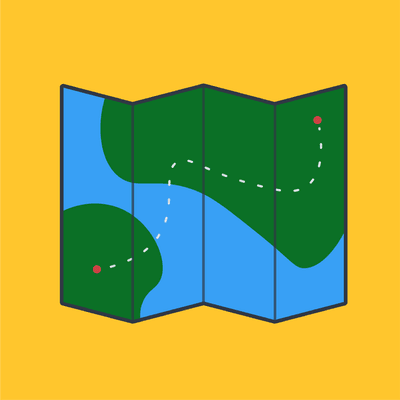

- Acknowledgements for PhD Thesis and Dissertations – Explained
- Doing a PhD
The Purpose of Acknowledgements
The acknowledgement section of a thesis or dissertation is where you recognise and thank those who supported you during your PhD. This can be but is not limited to individuals, institutions or organisations.
Although your acknowledgements will not be used to evaluate your work, it is still an important section of your thesis. This is because it can have a positive (or negative for that matter) influence the perception of your reader before they even reach the main body of your work.
Who Should I Acknowledge?
Acknowledgements for a PhD thesis will typically fall into one of two categories – professional or personal.
Within these categories, who you thank will ultimately be your decision. However, it’s imperative that you pay special attention to the ‘professional’ group. This is because not thanking someone who has played an important role in your studies, whether it be intentional or accidental, will more often than not be seen as a dismissal of their efforts. Not only would this be unfair if they genuinely helped you, but from a certain political aspect, it could also jeopardise any opportunities for future collaborations .
Professional Acknowledgements
This may include, but is not limited to:
- Funding bodies/sponsorship providers
- Supervisors
- Research group and lab assistants
- Research participants
- Proofreaders
Personal Acknowledgements
- Key family members and friends
- Individuals who inspired you or directly influenced your academic journey
- Anyone else who has provided personal support that you would like to mention
It should be noted that certain universities have policies which state only those who have directly supported your work, such as supervisors and professors, should be included in your acknowledgements. Therefore, we strongly recommend that you read your university guidelines before writing this section of your thesis.
How to Write Acknowledgements for PhD Thesis
When producing this section, your writing style can be more informal compared to the rest of your thesis. This includes writing in first person and using more emotive language. Although in most cases you will have complete freedom in how you write this section of your thesis, it is still highly advisable to keep it professional. As mentioned earlier, this is largely because it will be one of the first things your assessors will read, and so it will help set the tone for the rest of your work.
In terms of its structure, acknowledgements are expected to be ordered in a manner that first recognises the most formal support before moving onto the less formal support. In most cases, this follows the same order that we have outlined in the ‘Who Should I Thank’ section.
When thanking professionals, always write out their full name and provide their title. This is because although you may be on a first-name basis with them, those who read your thesis will not. By providing full names and titles, not only do you help ensure clarity, but it could also indirectly contribute to the credibility of your thesis should the individual you’re thanking be well known within your field.
If you intend to include a list of people from one institution or organisation, it is best to list their names in alphabetical order. The exception to this is when a particular individual has been of significant assistance; here, it would be advisable to list them.
How Long Should My Acknowledgements Be?
Acknowledgements vary considerably in length. Some are a single paragraph whilst some continue for up to three pages. The length of your acknowledgement page will mostly depend on the number of individuals you want to recognise.
As a general rule, try to keep your acknowledgements section to a single page. Although there are no word limits, creating a lengthy acknowledgements section dilutes the gratitude you’re trying to express, especially to those who have supported you the most.
Where Should My Acknowledgements Go?
In the vast majority of cases, your acknowledgements should appear directly after your abstract and before your table of contents.
However, we highly advise you to check your university guidelines as a few universities set out their own specific order which they will expect you to follow.
Phrases to Help You Get Started

We appreciate how difficult it can be to truly show how grateful you are to those who have supported you over the years, especially in words.
To help you get started, we’ve provided you with a few examples of sentences that you can complete or draw ideas from.
- I am deeply grateful to XXX…
- I would like to express my sincere gratitude to XXX…
- I would like to offer my special thanks to XXX…
- I would like to extend my sincere thanks to XXX…
- …for their assistance at every stage of the research project.
- …for their insightful comments and suggestions.
- …for their contribution to XXX.
- …for their unwavering support and belief in me.
Thesis Acknowledgement Examples
Below are three PhD thesis acknowledgment samples from which you can draw inspiration. It should be noted that the following have been extracted from theses which are freely available in the public domain. Irrespective of this, references to any individual, department or university have been removed for the sake of privacy.
First and foremost I am extremely grateful to my supervisors, Prof. XXX and Dr. XXX for their invaluable advice, continuous support, and patience during my PhD study. Their immense knowledge and plentiful experience have encouraged me in all the time of my academic research and daily life. I would also like to thank Dr. XXX and Dr. XXX for their technical support on my study. I would like to thank all the members in the XXX. It is their kind help and support that have made my study and life in the UK a wonderful time. Finally, I would like to express my gratitude to my parents, my wife and my children. Without their tremendous understanding and encouragement in the past few years, it would be impossible for me to complete my study.
I would like to thank my supervisors Dr. XXX and Dr. XXX for all their help and advice with this PhD. I would also like to thank my sisters, whom without this would have not been possible. I also appreciate all the support I received from the rest of my family. Lastly, I would like to thank the XXX for the studentship that allowed me to conduct this thesis.
I would like to thank my esteemed supervisor – Dr. XXX for his invaluable supervision, support and tutelage during the course of my PhD degree. My gratitude extends to the Faculty of XXX for the funding opportunity to undertake my studies at the Department of XXX, University of XXX. Additionally, I would like to express gratitude to Dr. XXX for her treasured support which was really influential in shaping my experiment methods and critiquing my results. I also thank Dr. XXX, Dr. XXX, Dr. XXX for their mentorship. I would like to thank my friends, lab mates, colleagues and research team – XXX, XXX, XXX, XXX for a cherished time spent together in the lab, and in social settings. My appreciation also goes out to my family and friends for their encouragement and support all through my studies.
Browse PhDs Now
Join thousands of students.
Join thousands of other students and stay up to date with the latest PhD programmes, funding opportunities and advice.
Dissertation Dedication Page Example
Information and ideas for writing your dissertation dedication..
- Read my article in Science Education based on my dissertation.
- Dissertation Acknowledgements
- Dissertation Dedication
- Dissertation Titles
- Publishing Your Dissertation
- Getting Noticed
In my case I used my dissertation dedication page to acknowledge someone who inspired me, beginning when I was five years old, to pursue a doctorate. This allowed me to provide a special honor while including a wider range of individuals in my dissertation acknowledgement. This is especially meaningful when you later present them with a hardcover copy of your dissertation.
The length of dissertation dedications varies quite a bit. I looked at dissertation dedication page examples from numerous dissertations as I wrote mine. I just did a random survey of ten dissertations and three did not include dedications. The other seven had an average of 23 words each. The dissertation dedications pages were brief and usually centered on a spouse, family members, or sometimes an influential mentor.
You can find dissertation dedication page examples from your school or advisor in Proquest Digital Dissertations .
Dissertation Main | Home
All rights reserved. © 2013 Wayne Breslyn Google

Dedication in Dissertation: 5 Tips for Consistent Progress
A dedication in a dissertation is a personal tribute to someone or a group of people who have inspired or helped the author with their thesis. It is usually a single sentence at the beginning of the dissertation, serving as a meaningful personal touch to acknowledge those who have supported the author throughout their research journey.
The importance of dedications in dissertations cannot be understated. They provide an opportunity for the author to express gratitude and appreciation to those who have played a significant role in their academic pursuits. Dedications can serve as a testament to the author’s personal and professional growth, as well as a way to honor individuals who have made a profound impact on their lives.
In this article, we will explore:
- The significance of dedications in dissertations
- Guidance on how to write them effectively
- Different types of dedications with examples
By understanding these aspects, you will be able to create a powerful dedication that adds value to your dissertation and resonates with your readers.
Types of Dedication in a Dissertation
1. informal dedication.
An informal dedication in a dissertation is a personal and heartfelt expression of gratitude to individuals who have played a significant role in the author’s academic journey. It is characterized by its casual and warm tone, often reflecting the author’s genuine emotions and appreciation. Informal dedications can take various forms, ranging from lighthearted anecdotes to sincere acknowledgments of support.
Examples of informal dedications in dissertations:
- “To my parents, whose unwavering encouragement and love have been my guiding light throughout this challenging but rewarding academic pursuit.”
- “In loving memory of my dear friend, whose passion for learning continues to inspire me every day.”
These examples illustrate how informal dedications can encompass diverse sentiments, making them deeply personal and meaningful to the author.
2. Formal Dedication
When it comes to dedications in dissertations , there are various types that authors can choose from to express their gratitude and appreciation. In addition to informal dedications, another common type is the formal dedication. Let’s explore what a formal dedication entails and provide some examples of how it can be incorporated into dissertations.
A formal dedication is characterized by its professional tone and structure. It is usually concise and straightforward, focusing on expressing gratitude to specific individuals or groups who have played a significant role in supporting the author throughout their research journey. Unlike informal dedications, which may incorporate personal anecdotes or lighthearted language, formal dedications maintain a more serious and respectful tone.
Here are a few examples of formal dedications found in dissertations:
- “To my advisor, Dr. Jane Smith, whose guidance and expertise have been invaluable in shaping this research.”
- “In memory of my late grandfather, John Johnson, whose unwavering support and encouragement inspired me to pursue this academic endeavor.”
- “To my parents, John and Sarah Davis, for their unwavering belief in my abilities and constant encouragement throughout this challenging process.”
As you can see from these examples, formal dedications focus on acknowledging specific individuals who have made a significant impact on the author’s academic journey. By adopting a more formal tone, these dedications convey a sense of professionalism while still expressing heartfelt gratitude.
3. Anecdotal Dedication
Anecdotal dedication in a dissertation involves sharing a personal story or experience that reflects the author’s gratitude or appreciation. This type of dedication often includes a brief narrative that adds a personal touch to the acknowledgment section. Anecdotal dedications aim to connect with the readers on an emotional level by sharing a specific event or memory that highlights the support or inspiration received during the dissertation process.
Examples of anecdotal dedications in dissertations:
- “To my late grandmother, whose unwavering belief in my academic pursuits continues to inspire me every day. Your wisdom and encouragement have been the guiding light throughout this journey.”
- “In loving memory of my mentor, Dr. Smith, whose passion for research and dedication to teaching have left an indelible mark on my academic pursuits. Your guidance will forever resonate in my work.”
These examples illustrate how anecdotal dedications can capture personal connections and honor individuals who have made a meaningful impact on the author’s academic endeavors.

4. Memorial Dedication
A memorial dedication in a dissertation is a heartfelt tribute to someone who has passed away and had a significant impact on the author’s academic journey. It serves as a touching remembrance and acknowledges the influence and support provided by the individual, despite their absence during the completion of the dissertation.
Here are some examples of memorial dedications in dissertations:
- “In loving memory of my dear mentor, Professor John Smith, whose wisdom and guidance continue to inspire my academic pursuits. Your legacy lives on through this work.”
- “Dedicated to the loving memory of my grandmother, whose unwavering belief in education has been the guiding light throughout my scholarly endeavors. Your spirit remains with me always.”
Guidelines for Writing an Impactful Dedication in Your Dissertation
When it comes to writing a dedication in your dissertation, it is essential to choose the right words and create a meaningful connection with your audience. Here are some guidelines to help you write an impactful dedication:
- Choose an Appropriate Dedication : Consider who your audience is and select a dedication that resonates with them. Think about the people who have supported you throughout your research journey and consider their interests, values, and contributions. This will ensure that your dedication is relevant and meaningful to those reading your dissertation.
- Establish a Personal Connection : The dedication section is an opportunity to express gratitude and appreciation to the individuals or groups who have played a significant role in your academic pursuits. To establish a personal connection, you can use specific names, anecdotes, or shared experiences that demonstrate the impact these individuals have had on your work. This personal touch adds depth and authenticity to the dedication.
- Craft an Effective Dedication Sentence : The dedication sentence sets the tone for the entire section. It should be concise yet powerful, capturing the essence of your gratitude in just a few words. Consider using vivid language or poetic elements to make it memorable. For example:
“To my parents, whose unwavering support has been my guiding light through this academic journey.”
- Express Gratitude and Appreciation : The dedication is an opportunity to express your heartfelt thanks to those who have contributed to your success. Be genuine and specific in acknowledging their support, guidance, or inspiration. You can highlight specific instances where their assistance was particularly valuable or mention how their encouragement kept you motivated during challenging times.
“I am grateful for Professor Smith’s invaluable guidance and mentorship throughout this research process. Their expertise and unwavering belief in my abilities have shaped me into the researcher I am today.”
“To my partner, who provided endless love, encouragement, and sacrifices during this demanding journey. Your unwavering support kept me going even when I doubted myself.”
Remember, the dedication is a way to honor and recognize those who have been instrumental in your academic success. Take the time to carefully consider your words and ensure that they truly reflect your gratitude and appreciation.
By following these guidelines, you can create an impactful dedication that not only acknowledges the support you received but also adds a personal touch to your dissertation.
Etiquette for Including Dedications in Dissertations
When including dedications in your dissertation, it’s important to follow proper etiquette guidelines and maintain professionalism. Here are some key things to consider:
- Relevance : Make sure the dedication relates to the academic context of the dissertation and fits with the overall tone of the work.
- Appropriateness : Be careful when choosing who to mention in the dedication, considering their connection to the research and the formal nature of the document.
- Respect : Be sensitive to personal matters and privacy, especially when writing memorial dedications or personal stories.
- Consistency : Keep the formatting and language consistent throughout the dedication section to present a professional appearance.
- Professional Tone : Use language that is appropriate for a formal document, even in informal dedications, to show sincerity while maintaining scholarly standards.
Following these guidelines will ensure that your dissertation’s dedications add value to your work and show gratitude and respect to those who have supported you academically.
The dedication in a dissertation is an important way to honor and thank those who have supported you during your academic journey. It’s a chance to show gratitude to the people who have helped you with your research. By acknowledging their impact, you are adding a meaningful personal touch to your dissertation, creating a lasting record of the connections and relationships that have enriched your academic pursuit.
Whether it’s an informal dedication filled with warmth and personal stories or a formal dedication showing respect and thanks, recognizing those who have played a crucial role in your dissertation is a powerful gesture. It shows not only appreciation but also reveals your character and integrity as a researcher.
The dedication section in your dissertation is more than just a customary part at the beginning; it represents the essence of your academic journey, reflecting the relationships, experiences, and connections that have shaped your scholarly pursuits. In this way, dedications go beyond being formalities; they are evidence of how human connections are vital in the quest for knowledge.
As you prepare to write your dedication, see it as an opportunity to genuinely express gratitude and make a lasting impact on your readers.
Needs help with similar assignment?
We are available 24x7 to deliver the best services and assignment ready within 3-4 hours? Order a custom-written, plagiarism-free paper
We provide reliable and top-quality writing services with a great balance of affordability and professionalism with all types of academic papers.
Quick Links
- College Admission Essay Writing Services FAQ
- Nursing Case Studies Writing Services
- Buy Custom Research Papers
- Best Nursing Writing Services
- Literary Analysis Essay Writers
- Nursing Paper Writers for Hire
- Professional Paper Writers
- Cheapest Essay Writing Services
- Write My Essay for Me
- The Best Research Paper Writing Services
- Admission Essay Writing Services!
- Shakespeare Essay Writing Services!
- Rewriting Services
- Term Paper Writing Service

Useful Resources
Dissertation Writing Services
Essay Writer For Hire
Free Essay Maker
How to Study

Dissertation
Ai generator.
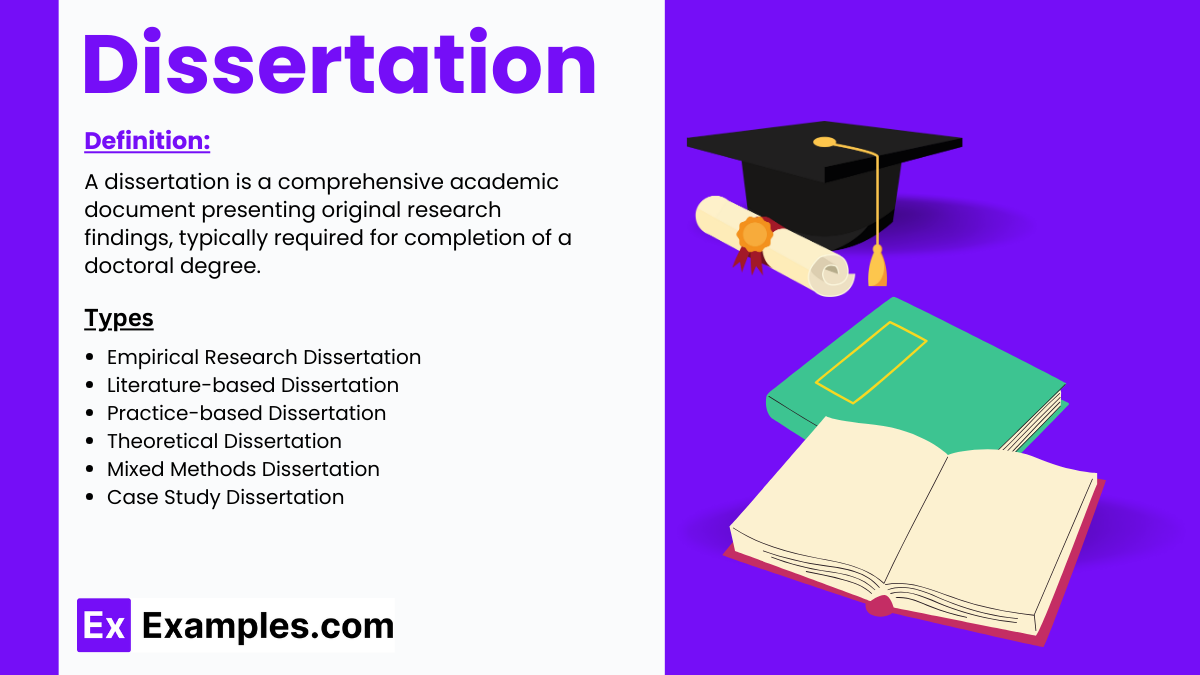
Dissertations are structured documents that present findings, arguments, and conclusions in a formal manner. They demonstrate a student’s ability to conduct independent research, critically evaluate literature, and communicate complex ideas effectively.
What is a Dissertation?
A dissertation is a comprehensive research project often pursued at the postgraduate level. It involves extensive study, analysis, and original contributions to a specific field. Dissertations showcase a student’s ability to conduct independent research, critically evaluate literature, and communicate complex ideas effectively.
Pronunciation of Dissertation
- American English Pronunciation : In American English, “dissertation” is pronounced as /ˌdɪs.ərˈteɪ.ʃən/.
- British English Pronunciation : In British English, the pronunciation is /ˌdɪs.əˈteɪ.ʃən/.
- Dis- : This syllable is pronounced with a short “i” sound, like in the word “this”.
- -ser- : The middle syllable is pronounced with a short “e” sound, similar to “set”.
- -tay- : This part is pronounced with a long “a” sound, as in “day”.
- -shun : The final syllable has the “shun” sound, like in “mission”.
- The stress is typically on the second syllable in both American and British English.
- It’s important to enunciate each syllable clearly for correct pronunciation.
Types of Dissertations
- Conducts original research using empirical methods.
- Involves data collection, analysis, and interpretation.
- Common in scientific and social science disciplines.
- Focuses on analyzing and synthesizing existing literature.
- Examines theories, concepts, or debates within a field.
- May involve a systematic review or meta-analysis.
- Integrates theoretical knowledge with practical application.
- Often found in professional fields like education , business , or healthcare.
- Includes a reflective component on real-world experiences.
- Explores and develops new theories or conceptual frameworks.
- Emphasizes conceptual analysis and argumentation.
- Common in philosophy , theoretical physics , and humanities.
- Combines qualitative and quantitative research approaches.
- Offers a comprehensive understanding of complex phenomena.
- Utilizes both data collection methods for triangulation.
- Focuses on in-depth examination of a specific case or phenomenon.
- Provides detailed insights into real-life contexts .
- Often used in psychology , sociology, and business research.
Dissertation Format
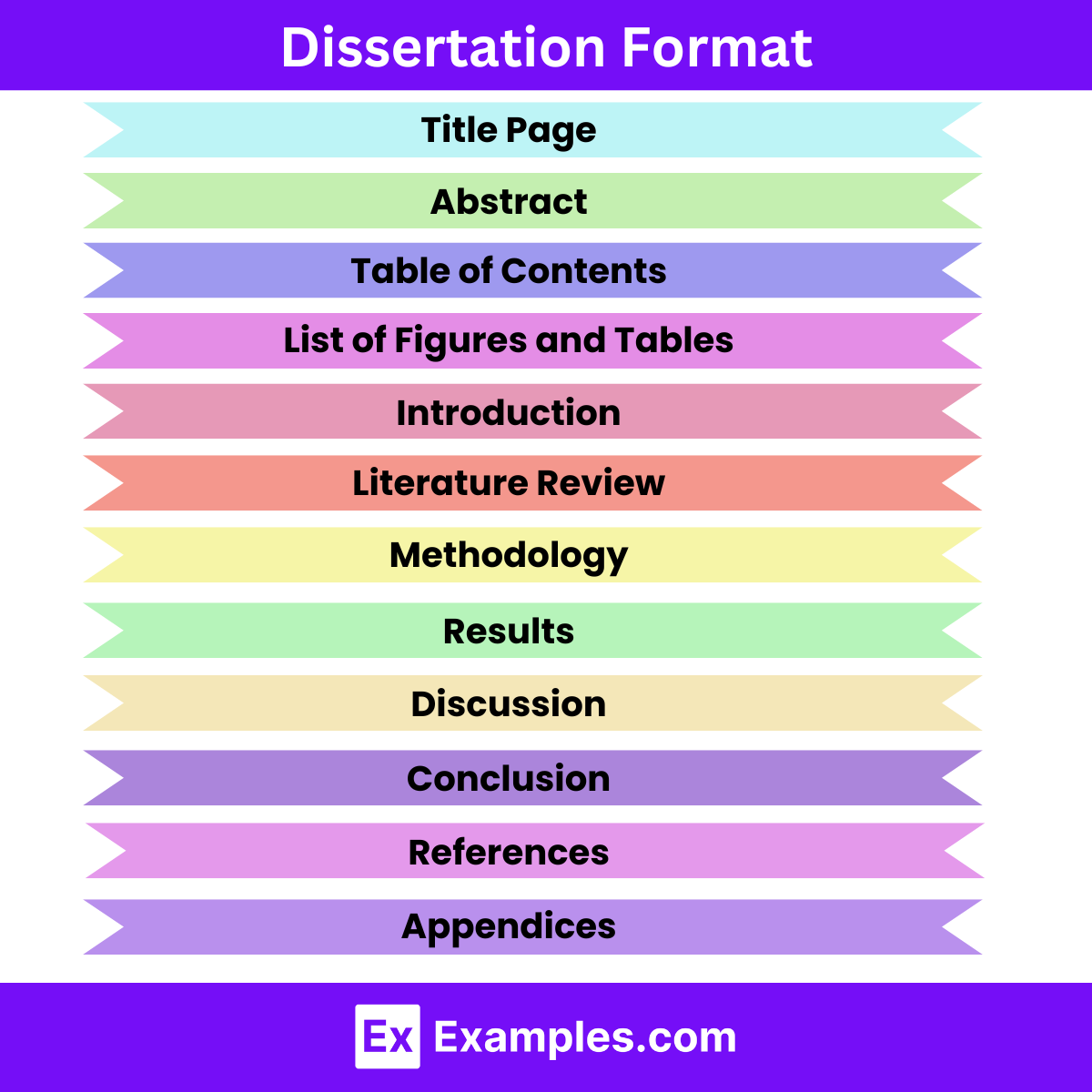
Here’s an overview of the typical format for a dissertation:
- Includes the title of the dissertation, author’s name, institution, department, degree program, date, and possibly the supervisor’s name.
- Provides a concise summary of the dissertation’s purpose, methodology, key findings, and conclusions.
- Usually limited to a certain word count or character limit.
- Lists the main sections and subsections of the dissertation with corresponding page numbers.
- Enumerates all figures and tables included in the dissertation, along with their respective page numbers.
- Sets the stage for the research by introducing the topic, context, significance, objectives, and research questions.
- Provides an overview of the structure of the dissertation.
- Surveys relevant literature and theoretical frameworks related to the research topic.
- Analyzes and synthesizes existing research to establish a theoretical foundation for the study.
- Describes the research design, methods, data collection procedures, and analysis techniques used in the study.
- Justifies the chosen methodology and explains how it aligns with the research objectives.
- Presents the findings of the research in a clear and organized manner.
- Includes tables, figures, and descriptive statistics to illustrate the data.
- Interprets the results in relation to the research questions, hypotheses, and theoretical framework.
- Analyzes the implications of the findings and discusses their significance in the broader context of the field.
- Summarizes the main findings and their implications for theory, practice, or policy.
- Reflects on the limitations of the study and suggests directions for future research.
- Lists all the sources cited in the dissertation in a consistent citation style (e.g., APA, MLA, Chicago).
- Includes supplementary materials such as questionnaires, interview transcripts, or raw data.
- Provides additional details that support the main text but are not essential for understanding the dissertation.
Dissertation Topics
Here are some broad categories of dissertation topics, along with examples within each category:
- The impact of technology on student learning outcomes.
- Strategies for improving student engagement in online education.
- The effectiveness of inclusive education programs for students with disabilities.
- Assessing the role of parental involvement in children’s academic achievement.
- Investigating the relationship between teacher motivation and student performance.
- The influence of corporate social responsibility on consumer behavior.
- Strategies for managing workplace diversity and inclusion.
- Analyzing the factors affecting employee job satisfaction and retention.
- The role of leadership styles in organizational change management.
- Exploring the impact of digital marketing on consumer purchase decisions.
- Assessing the effectiveness of telemedicine in improving patient access to healthcare services.
- Investigating the psychological effects of long-term illness on patients and their families.
- Analyzing the factors influencing healthcare professionals’ adoption of electronic health records.
- Exploring the role of preventive healthcare interventions in reducing the prevalence of chronic diseases.
- Assessing the impact of healthcare policies on healthcare equity and access.
- Understanding the relationship between social media use and mental health outcomes among adolescents.
- Investigating the factors influencing public perceptions of climate change and environmental policies.
- Exploring the impact of immigration policies on immigrant integration and social cohesion.
- Analyzing the effects of income inequality on social mobility and economic development.
- Assessing the effectiveness of community-based interventions in reducing crime rates.
- Investigating the adoption and diffusion of renewable energy technologies in developing countries.
- Analyzing the ethical implications of artificial intelligence and machine learning algorithms.
- Exploring the role of blockchain technology in revolutionizing supply chain management.
- Assessing the impact of smart city initiatives on urban sustainability and quality of life.
- Investigating the factors influencing consumers’ acceptance of autonomous vehicles.
Synonym & Antonyms For Dissertation
How to write a dissertation.
Writing a dissertation is a comprehensive process that requires careful planning and execution. Here’s a step-by-step guide on how to write a dissertation:
- Select a topic that aligns with your interests, expertise, and the requirements of your academic program.
- Ensure the topic is researchable, relevant, and contributes to the existing body of knowledge in your field.
- Conduct a thorough literature review to familiarize yourself with existing research on your topic.
- Identify gaps, controversies, or unanswered questions that your dissertation can address.
- Develop research questions or hypotheses to guide your study.
- Outline the purpose, scope, objectives, and methodology of your dissertation in a research proposal.
- Seek feedback from your advisor or committee members and revise the proposal accordingly.
- Develop a detailed timeline or schedule for completing each stage of the dissertation writing process.
- Break down tasks into manageable chunks and set deadlines for completing each chapter or section.
- Start with the introduction, which provides background information, states the research objectives, and outlines the structure of the dissertation.
- Proceed to the literature review, methodology, results, discussion, and conclusion chapters, following the structure outlined in your proposal.
- Write each chapter systematically, using clear and concise language, and supporting your arguments with evidence from research.
- Review each draft of your dissertation carefully, focusing on clarity, coherence, and logical flow of ideas.
- Edit for grammar, punctuation, spelling, and formatting errors.
- Seek feedback from your advisor, peers, or academic writing support services, and incorporate suggested revisions.
- Compile all chapters, appendices, tables, figures, and references into a cohesive document.
- Ensure consistency in formatting and citation style throughout the dissertation.
- Proofread the final version to ensure accuracy and completeness.
- Submit the finalized dissertation to your advisor or committee for review and approval.
- Prepare for a dissertation defense, where you’ll present your research findings and answer questions from your committee.
- Address any feedback or revisions requested by your committee and finalize the dissertation for submission.
Dissertation vs. Thesis
Examples of dissertation in education.
- Investigating the effectiveness of flipped classroom approaches in enhancing student engagement and academic performance across various subjects.
- Analyzing the correlation between emotional intelligence levels among teachers and their ability to create supportive learning environments and facilitate student success.
- Examining the benefits of parental involvement in early childhood education and identifying effective strategies for promoting collaboration between families and schools.
- Investigating disparities in access to technology resources among students from different socio-economic backgrounds and exploring interventions to bridge the digital divide.
- Assessing the effectiveness of multicultural education programs in fostering cultural competence, diversity awareness, and inclusivity among students in diverse learning environments.
- Evaluating the effectiveness of social-emotional learning (SEL) interventions in promoting mental health, resilience, and well-being among students, teachers, and school staff.
- Identifying barriers to gender equity in STEM (science, technology, engineering, and mathematics) education and exploring strategies to encourage girls’ participation and success in STEM fields.
- Investigating the knowledge, attitudes, and practices of teachers related to assessment and exploring professional development initiatives to improve assessment literacy and enhance student learning outcomes.
- Examining the implementation of inclusive education policies and practices for students with disabilities, including challenges faced, effective strategies, and policy implications for inclusive schooling.
- Analyzing the impact of school leadership practices on teacher professional development, instructional quality, and overall school improvement efforts.
Examples of Dissertation in Psychology
- Investigating the relationship between social media usage patterns and the prevalence of depression, anxiety, and other mental health issues among adolescents.
- Examining the efficacy of cognitive-behavioral therapy (CBT) in treating anxiety disorders and exploring the underlying mechanisms of therapeutic change.
- Assessing the long-term effects of different parenting styles (e.g., authoritarian, authoritative, permissive) on children’s emotional regulation, social skills, and overall development.
- Investigating the neurobiological mechanisms underlying addiction and exploring implications for developing more effective treatment and prevention strategies.
- Examining the factors that contribute to psychological resilience in individuals who have experienced trauma, such as childhood abuse, natural disasters, or combat exposure.
- Investigating the bidirectional relationship between sleep quality and mental health outcomes, including the impact of sleep disturbances on emotional regulation and psychological well-being.
- Comparing cultural differences in the conceptualization and assessment of personality traits, such as individualism-collectivism, and exploring implications for cross-cultural psychology.
- Evaluating the effectiveness of mindfulness-based interventions (e.g., mindfulness-based stress reduction, mindfulness-based cognitive therapy) in reducing stress, improving well-being, and enhancing psychological resilience.
- Examining the role of sociocultural factors (e.g., media influence, peer pressure) in shaping body image ideals and exploring interventions to prevent and treat eating disorders.
- Investigating the psychological processes underlying procrastination behavior, including motivational factors, self-regulation strategies, and interventions to promote task completion and productivity.
Examples of Dissertation in literature
- Understanding how stories from countries once colonized talk about who they are and where they fit in the world.
- Checking out how women are shown and what roles they have in old stories from the Victorian times.
- Finding out why scary stories from the past are still popular now and what they’re all about.
- Seeing how heroes are the same in stories from different places and why they’re important to us.
- Learning from stories that care about nature and how writers make us think about protecting the environment.
- Finding out why some new stories are tricky and playful with how they’re written, and what makes them special.
- Understanding how people who lived through terrible events tell their stories, and why it’s important.
- Seeing how Black artists in Harlem made cool stuff and changed how people think about Black culture.
- Exploring stories about moving to new places and how they mix different cultures together.
- Checking out how Shakespeare’s stories get turned into movies and other fun things we like today.
Examples of Dissertation in Politics
- Investigating how different types of political systems, such as democracies and autocracies, influence economic development and growth.
- Analyzing government policies and international agreements aimed at addressing climate change and their effectiveness in mitigating environmental degradation.
- Exploring the rise of populist movements and their impact on political polarization, democratic norms, and institutions.
- Examining the ethical and legal considerations surrounding humanitarian intervention and the protection of human rights in conflict zones.
- Investigating the role of nationalism and identity politics in shaping public attitudes towards immigration, multiculturalism, and social integration.
- Analyzing the effects of globalization on state sovereignty, economic policies, and the balance of power between states and multinational corporations.
- Comparing different electoral systems and their impact on political representation, party competition, and the functioning of democratic institutions.
- Examining the tension between national security concerns and civil liberties, particularly in the context of counterterrorism policies and surveillance practices.
- Assessing the barriers to women’s political participation and representation in decision-making roles, and exploring strategies for achieving gender equality in politics.
- Analyzing the role of the United Nations and other international organizations in addressing global challenges, such as conflict resolution, humanitarian crises, and sustainable development.
What exactly is a Dissertation?
A dissertation is a scholarly document that presents original research on a specific topic, typically completed as part of a doctoral program. It demonstrates the candidate’s ability to conduct independent research and contribute to their field of study.
How long is a Dissertation?
The length of a dissertation varies widely depending on the academic discipline, program requirements, and research topic. On average, it ranges from 80 to 200 pages, but some dissertations can be shorter or longer based on the depth and scope of the research.
What Do You Write a Dissertation For?
A dissertation is written as a culmination of doctoral studies to demonstrate a candidate’s ability to conduct independent research, contribute new knowledge to their field, and obtain a doctoral degree. It showcases expertise, critical thinking, and scholarly communication skills.
Text prompt
- Instructive
- Professional
10 Examples of Public speaking
20 Examples of Gas lighting
- Latest Articles
- Top Articles
- Posting/Update Guidelines
- Article Help Forum
- View Unanswered Questions
- View All Questions
- View C# questions
- View C++ questions
- View Javascript questions
- View Visual Basic questions
- View Python questions
- CodeProject.AI Server
- All Message Boards...
- Running a Business
- Sales / Marketing
- Collaboration / Beta Testing
- Work Issues
- Design and Architecture
- Artificial Intelligence
- Internet of Things
- ATL / WTL / STL
- Managed C++/CLI
- Objective-C and Swift
- System Admin
- Hosting and Servers
- Linux Programming
- .NET (Core and Framework)
- Visual Basic
- Web Development
- Site Bugs / Suggestions
- Spam and Abuse Watch
- Competitions
- The Insider Newsletter
- The Daily Build Newsletter
- Newsletter archive
- CodeProject Stuff
- Most Valuable Professionals
- The Lounge
- The CodeProject Blog
- Where I Am: Member Photos
- The Insider News
- The Weird & The Wonderful
- What is 'CodeProject'?
- General FAQ
- Ask a Question
- Bugs and Suggestions
gRPC, .NET 8.0 and Kestrel in Easy Samples

- Download sample code
Web gRPC Under ASP.NET 8.0, Kestrel with HTML/JavaScript and Avalonia Clients
This dedication is my farewell present to my good friends at Kahua.com including
- Colin Whitlock - who on top of being a great CTO, is also a great manager, architect and developer in the company.
- Jon Sinsel - an extremely sharp C# guru who very patiently introduced me to Uno Platform and Kahua code.
- Adam Love - the best Web, Mobile wizard (also a great C# developer) without whose help, I'd still be figuring out things about deploying ASP.NET application.
- Jonas Mayor - terrific C# software engineer who introduced me to IIS URL Rewrite module and ASP.NET middleware.
Introduction
gRPC is an abbreviation for "Google Remote Procedure Calls". It is a high performance multi-platform technology for communications between a server and clients.
Here are the gRPC advantages:
- gRPC messages are much smaller than those of the text based protocols (REST and SOAP), correspondingly gRPC communications are much faster.
- gRPC can be used for Web communications.
- gRPC supports Server side streaming This is important, because many other popular Web protocols e.g. REST do not support streaming.
- gRPC (except from a browser) supports Client side as well as the bidirectional streaming (both client and server exchanging information via established streams at the same time). gRPC in browser not supporting client side streaming is a pretty bad limitation that might require switching to other technologies e.g. SignalR for chatty clients.
- Both Server and Client gRPC can be run virtually on any platform and use various different software languages including, but not limited to C#, Java, JavaScript, Python.
- gRPC is very simple and easy to learn.
Kestrel and ASP.NET 8.0
The gRPC service is implemented as part of Kestrel ASP.NET server.
Kestrel is a Microsoft Web server written entirely in .NET Core and because of that it is 100% multiplatform.
Kestrel is great for handling ASP.NET and gRPC requests/responses, but misses some Web server features and because of that is often deployed behind another Web server which plays role of a reverse proxy for ASP and gRPC requests/responses.
On Windows the reverse proxy server is usually IIS while on Linux it can be Apache or anything else:
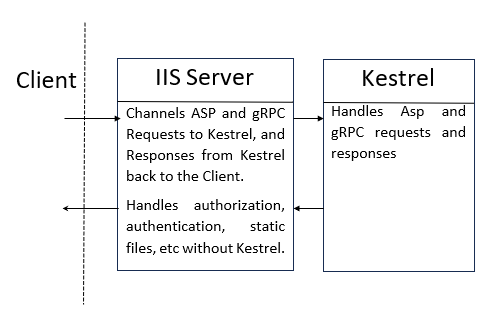
The integration between IIS and Kestrel comes naturally in .NET 8.0 and requires almost no code change.
Avalonia is a great open source .NET framework for writing UI on multiple platforms (including Windows, MacOS, Linux, WebAssembly, Android and iOS) using C# and XAML.
On top of being multiplatform, Avalonia framework is considerably better and more powerful than WPF or any JavaScript/TypeScript framework.
Avalonia allows creating applications of great speed and quality and has very few differences in the way it behaves on various platforms.
Avalonia can be used for creating Web applications using WebAssembly.
The Main Purpose of the Article
This article provides easy and well explained samples for building and deploying gRPC services using IIS/Kestrel ASP.NET functionality on Windows and consuming them by various gRPC Clients. Here are the gRPC clients presented in the article:
- C# Console Program (would work exactly the same in C# desktop applications on any platform).
- HTML/JavaScript Web broser client.
- C# Non-Blazor Avalonia WebAssembly client. The reason I prefer not using Blazor is because from different sources on the Web I read that non-Blazor technology for C# WebAssembly and its interaction with HTML/JavaScript is more stable.
Important Note on Using ASP.NET
I'd like underscore that ASP.NET is often used to generate the HTML/JavaScript pages on the fly.
For application speed sake and clarity reasons, I prefer using ASP.NET for providing backend services only without almost any HTML/JavaScript generation.
One exception to the rule above is - sometimes, I add the constant global configuration parameters to ASP.NET pages via code generation only at the initial state (when the page is loaded the first time).
The AWebPros.com Website Demonstrating the gRPC Samples running under IIS/Kestrel
Using the code described in this article, I built a Website ASP gRPC Samples demonstrating web HTML/JavaScript and Avalonia WebAssembly client with IIS/Kestrel web server.
This article concentrates primarily on gRPC related code.
My wonderful journey through building and deploying a real life APS.NET web site I plan to describe in future articles. In particular I plan covering the following topics:
- WebAssembly, Avalonia and ASP.NET.
- Installing Hosting Bundle so that your ASP.NET would run under IIS.
- Using IIS/Kestrel in and out of hosting model.
- Using Cors.
- Obtaining and deploying a free SSL certificate so that your website would not be marked as insecure by Web browsers.
- Wiring ASP.NET Response Compression for WebAssembly files to improve speed.
- Deploying ASP.NET web sites using Publish.
No gRPC Client Streaming in Browser (unfortunately)
There is a known limitation of grpc-web (the only gRPC framework that can be used for gRPC browser based clients) - it allows only server side streaming ( gRPC-Web Streaming ).
No client streaming or bidirectional streaming is allowed.
Using gRPC over WebAssembly has appearance of allowing Client side and bidirectional streaming, but in fact it is not correct.
As we shall learn from the samples below, when you try to stream from a Web Browser client, the messages are not sent one by one, but instead they are accumulated on the client until the client indicates the end of streaming. Then all the accumulated messages are sent to the server together.
gRPC ASP.NET Code Samples
The source code.
The source code for this article is located under ASP.NET gRCP Samples .
In order to maximize the code reuse between various samples, I built an all encompassing solution - AspGrpcTests.sln (which you never have to open) and a number of filtered solutions (.slnf) files around it. The .slnf files filter in the functionality specific to each sample.
Kestrel only Code Sample
Opening and running the kestrel only solution.
Kestrel can be used without IIS as a stand-alone process or Windows service. This sample (located in GrpcKestrelOnlyImplementation.slnf solution filter) demonstrates gRPC communications between a Kestrel-only server running as a console process and a local C# console client.
To run this sample open GrpcKestrelOnlyImplementation.slnf in Visual Studio 2022. You can see the following projects and files in the solution explorer:
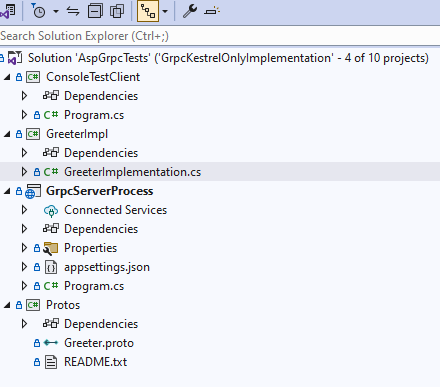
GrpcServerProcess is the project containing the Kestrel server and ConsoleTestClient is the project to start the local gRPC C# client.
Start the server process first (by right-clicking GrpcServerProcess and selecting Debug->Run Without Debugging). This will start the Kestrel server as a process on your windows. Note, that since the output of the server in not in HTML format, it will start a browser displaying an error something like ( This local page can't be found ). Do not worry about it and do not kill the browser if you want your server to continue running.
Then start the console client (project ConsoleTestClient) in the similar fashion. Here is what will be printed on the client console:
There are five gRPC scenarios demo'ed by this sample:
- Unary sample - client sends "Joe Doe" string to the server and it returns "Hello Joe Doe!".
- Streaming server sample - client sends single string ("Joe Doe") and returns multiple greetings.
- Streaming server sample with error - same as the streaming server sample above, only the server throws an RpcException in the middle of the stream (after the 11th iteration).
- Streaming client sample - client send multiple strings ("Client_1", "Client_2" and "Client_3") and the server concatenates them and returns the "Client_1, Client_2, Client_3" string.
- Bidirectional streaming sample - the client sends 3 requests within ("Client_1", "Client_2" and "Client_3") and the server responds with 4 responses for each of the client requests (everything is happening in simultaneously - new client requests can arrive while the server responds to the old ones).
A Note on the Code Overview
Since similar or identical code is used in the rest of the samples, I will provide a very detailed review of the gRPC server and client code in this sample, while in the future samples, I'll be only emphasizing the differences with the current code.
Source Code Overview
The source code for this sample consists of 4 projects:
- GrpcServerProcess - starting and running Kestrel server.
- GreeterImpl - a re-usable library containing the gRPC server functionality implementation (GrpcServerProcess depends on it).
- Protos - containing the Greeter.proto gRPC proto file shared between the server (via GreeterImpl) and the client.
- ConsoleTestClient - the console client for running all the client gRPC tests against the server (it depends on Protos project as well).
The project dependencies are reflected on the diagram below:
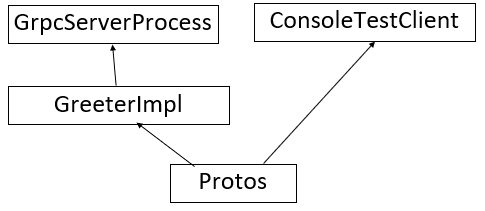
Protos project contains Greeter.proto file defining gRPC protos for the gRPC methods:
All the Greeter methods take HelloRequest message(s) as requests and return HelloReply messages as replies. I could have used built-in string protobuf Type for both, but wanted to show a more complex example with request and reply types defined in the proto file.
Note that there is an integer specified next to a field within HelloRequest and HelloReply protos, e.g.:
This integer should uniquely define a protobuf field, so that if new fields are added to the type , they should have different integers - in that case, the new expanded type will be backward compatible.
The most interesting server code is located within GreeterImplementation.cs file under the reusable GreeterImpl project.
Take a look at GreeterImpl.csproj file. It shows how to add a reference to a proto file contained by a different project:
We simply provide a relative path to the file.
The GrpcServices="Server" means that the server skeleton will be generated for the proto methods. Note that GreeterImpl project also has a reference to Grpc.AspNetCore package which has references needs to the generated the server skeleton.
GreeterImplementation class of GreeterImpl project inherits from the generated skeleton simple.Greeter.GreeterBase class. It provides overriding implementations for all the gRPC server methods, e.g here is the override for the simplest - single request/single reply SayHello(...) method:
GrpcServerProcess is the actual project that starts Kestrel server supporting the gRPC method implementations defined within GreeterImplementations class.
The local server port is defined within its appsettings.json file:
The rest of its functionality is contained within Program.cs file:
ConsoleTestClient project also references Greeter.proto file but with GrpcServices="Client" : That instructs the Visual Studio to generate client proxies for Greeter methods.
ConsoleTestClient also needs to provide references to Grpc.Net.Client, Google.Protobuf and Grpc.Tools packages:
The really interesting custom code is server implementations of gRPC methods and client calls to those methods. Server implementations are contained within GreeterImplementations.cs file (under the re-usable GreeterImpl project) and client calls are contained within Program.cs file of the ConsoleTestClient projects.
In the subsequent sections below I shall explain those methods one by one.
Single Request / Single Reply SayHello(...) method
This is the simplest method to implement and to call (since there is no either server or client side streaming).
Here is the protobuf code for this method from Greeter.proto file located under Protos project:
Here is the client code (from ConsoleTestClient/Program.cs file):
The code at the top of the snippet above connects the gRPC client to the grpc server at "https://localhost:55003" url and creates the greeterGrpcClient object to call the server methods.
The server call itself takes only one line:
We create the HelloRequest object setting its name to "Joe Doe", send it over to the server and wait for the reply.
reply.Msg will contain the "Hello Joe Doe!" greeting string.
The server implementation (located within GreeterImplementation.cs file) is also very simple:
The client call will result in the following msg printed to the console:
Server Streaming Samples
There are two Server Streaming samples - one plain ServerStreamHelloReplies(...) method and the other one with server throwing an RpcExeption in the middle of the streaming responses being sent back to the client ServerStreamHelloRepliesWithError(...) .
Here is the protobuf code for these two methods:
Here is the client code for the plain method (without server error):
The result of this client method call will be a stream of messages printed to the console:
The client code for the server streaming with error is very similar, only its is encased within try/catch block:
And here is what it prints to the console:
The server throws an error after the 11th iteration and the error message intended for the client is "Error Status Detail (for the client)" (the server can write another, more detailed, error message to its log).
Now let us take a look at the server implementations of the server streaming methods within GreeterImplementation.cs file:
Both methods call ServerStreamHelloRepliesImp(...) method, one passing the argument throwException set to false and the other set to true .
Note that the line:
serves to cancel the server streaming from the client side. Client side cancellation will be demo'ed later when we discuss the web clients.
Client Streaming Sample
Next sample (method Greeter.ClientStreamHelloRequests(...) ) demonstrates async streaming from the client, accumulating the results on the server and returning the single value result to the client after the client streaming ended.
Here is the protobuf declaration of this methods:
Here is the client code:
The server returns string "Hello " followed by the comma separated concatenation of the messages from the client:
Here is the server code:
Note, that the server receives each of the client messages as they are streamed, without waiting for the client streaming to end. You can observe it by running the server in a debugger and putting a breakpoint within the await foreach(...) loop.
Bidirectional Streaming Sample
Finally we came the most interesting and complex sample - the one that demonstrates streaming both client requests and server replies simultaneusly: the server does not wait for the client to finish its streaming it starts replying after each client request arrives.
The protobuf method is called Greeter.ClientAndServerStreamingTest(...) :
Note that both requests and replies are streamed.
Here is the client implementation of calling bidirectional streaming functionality:
The readTask defined at the top will be used to get the streaming replies, one by one.
Here is what the client prints to console:
For every string coming from the client, the server sends back 4 replies e.g. for Client_1, the replies will be Client_1_1, Client_1_2, Client_1_3 and Client_1_4.
Note that the interval between streaming client messages to the server is pretty large - 1 second and yet, there is almost no delay in server replies. This is because the server starts replying after the first client message is received and continues replying without waiting for the client streaming to be completed.
This is what the real bi-directional streaming is and unfortunately it will NOT work from the browser as will be explained below.
Overview of Browser Based Code Sample Code Samples
The rest of the ASP.NET gRPC code samples will be browser based. One sample demonstrates the HTML/JavaScript using gRPC to exchange information with the server and the other Avalonia WebAssembly.
The server gRPC code for those samples will be exactly the same as in the previous sample - located within GreeterImplementation.cs file under GreeterImpl project. Because of that we shall concentrate primarily on the client code and ASP.NET specific server code.
HTML/JavaScript ASP.NET gRPC Sample
Running the sample.
Start the solution filter AspGrpcServerWithRazorClient.slnf. Make AspGrpcServerWithRazorClient project to be your startup project. Build the project and run it under the debugger.
Here is the page you'll see:
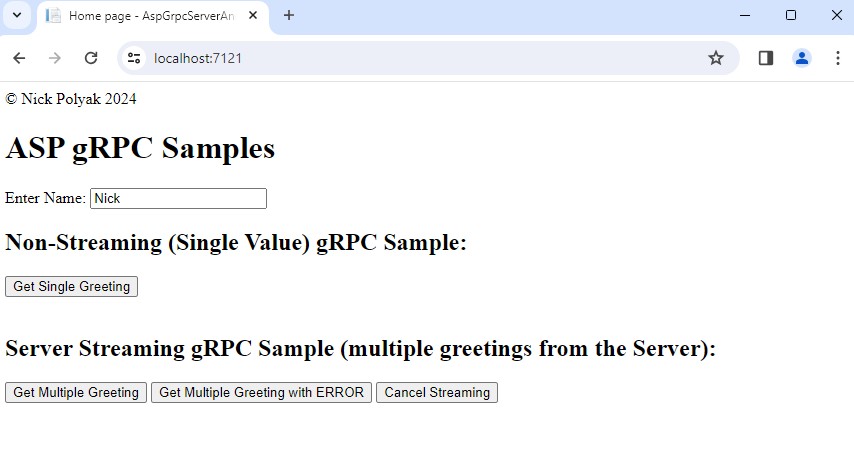
You can try changing the name (or leaving it set to "Nick"), then clicking "Get Single Greeting" button and you'll get "Hello Nick!!!" printed in the browser:
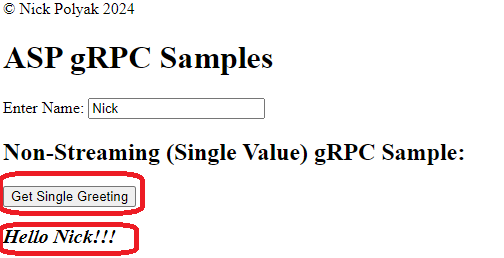
Now try clicking "Get Multiple Greetings" button. You will see multiple greeting streaming from the server from "Hello Nick 1" to "Hello Nick 20" and at the end it will print "STREAMING ENDED" (if you let it run to the end):

You can also cancel the server streaming at any point by pressing button "Cancel Streaming".
Pressing button "Get Multiple Greetings with ERROR" will call the on the server method that will throw an RpcException after 11th iteration. Here is how the resulting error is displayed:

Creating the ASP.NET Project for Hosting the Sample
I created the ASP.NET project AspGrpcServerWithRazorClient.csproj by choosing "ASP.NET Core Web App (Razor Pages)" project type:

Then I modified its Program.cs, Index.cshtml and _Layout.cshtml as will be detailed below.
Generating JavaScript Client Proxies from Protobuf Code
As a prerequisite for everything that follows, please, install nodeJS and npm e.g. by going to Node JS Install , downloading the node .msi installer and running it on your windows machine.
In order to build the server you need to
- Install protoc protobuffer compiler e.g. from Protoc Compiler Download by downloading and unzipping protoc-26.1-win64.zip (or some other file depending on your machine). Make sure protoc.exe is in your path.
- Generate the JavaScript client proxies from Greeter.proto protobuf file using protoc compiler. Protoc will generate nodeJS JavaScript proxies. Here is the command that needs to be run from a command line from inside the Protos folder (of the Protos project) to generate the client proxies: protoc -I=. Greeter.proto --js_out=import_style=commonjs:..\AspGrpcServerWithRazorClient\wwwroot\dist --grpc-web_out=import_style=commonjs,mode=grpcwebtext:..\AspGrpcServerWithRazorClient\wwwroot\dist This line is also contained in README.txt file within the same folder.
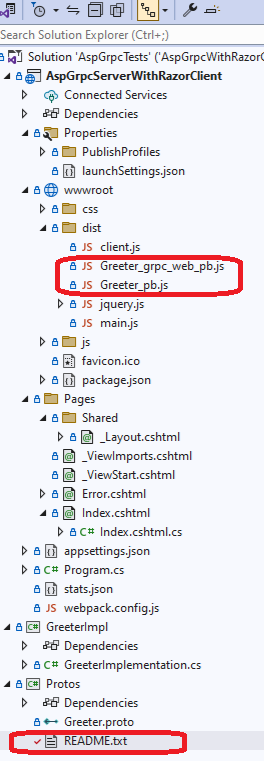
- There is a tiny JavaScript file AspGrpcServerWithRazorClient/wwwroot/dist/client.js that refers to all the functionality that the JavaScript client needs from the generated Greeter_..._pb.js files: JavaScript const { HelloRequest, HelloReply } = require( ' ./Greeter_pb.js' ); const { GreeterClient } = require( ' ./Greeter_grpc_web_pb.js' ); global.HelloRequest = HelloRequest; global.HelloReply = HelloReply; global.GreeterClient = GreeterClient; This file is used by webpack for generating the main.js file that can be used by the browser client.
- In order to use webpack file generation, we need to create webpack.config.js file at the project level. Here is its content: JavaScript const path = require( ' path' ); module.exports = { mode: ' development' , entry: ' ./wwwroot/dist/client.js' , output: { path: path.resolve(__dirname, ' wwwroot/dist' ), filename: ' main.js' , }, }; It will instruct webpack to take client.js and every file it depends on and based on them create main.js file (located under the same dist folder) which can be used by the JavaScript browser clients.
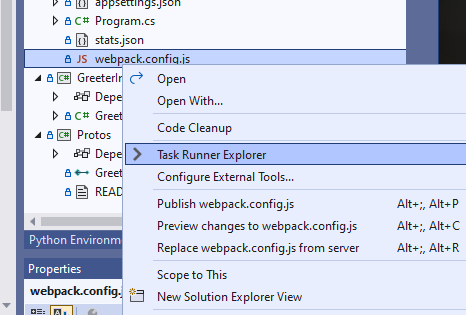
HTML/JavaScript Client Code Overview
HTML/JavaScript client code that uses the proxies generated in the previous subsection is located within AspGrpcServerWithRazorClient/Pages/Index.cshtml file. The file is virtually all HTML/JavaScript with no ASP code generation.
The HTML part of the file defines labels, buttons and divs (as placeholders for adding text):
Then two modules are added -
- main.js file generated in the previous subsection. main.js module is used get the client proxy code).
- jquery.min.js - for finding HTML tree nodes and modifying them.
And then finally there is JavaScript client code within <script type="text/javascript"> HTML tag.
Client Code to Create the gRPC Greeter Client
After creating the client greeterServiceClient , we use it for gRPC service calls.
Calling Single Request / Single Reply SayHello(...) Service from JavaScript Client
Here is how we call SayHello(...) service from JavaScript client:
This code itself is assigned using jQuery to be a callback on the "#GetSingleGreetingButton" click:
Calling Streaming gRPC Services form the Client
For server streaming calls we define a global variable var stream = null; and then use it to call the streaming services and to cancel them if needed.
For the sake of the code reuse there is a single JavaScript getStreamedGreetings(greeterServiceClient, throwError) method whose second argument is a Boolean flag - that should be set to true to call the gRPC streaming service that throws an error after the 11th iteration and false for the one that allows the streaming service to run all the way to the end.
Here is how streaming service invocation callbacks are assigned to the corresponding buttons:
Here is the getStreamedGreetings(...) method implementation (with detailed comments):
Canceling Server Streaming
All one needs to do is to cancel a server stream is to call stream.cancel("Cancellation Message") .
ASP.NET Code for Building and Starting ASP.NET Server
This code is located within well documented Program.cs file under AspGrpcServerWithRazorClient project:
ASP.NET Avalonia/WebAssembly gRPC Code Sample
To run the sample, please, open AspGrpcWithAvaloniaClients.slnf solution filter file, make AspGrpcServer the start-up project, then re-build it and start it.
Here is the screen you are going to see (after a second or too):
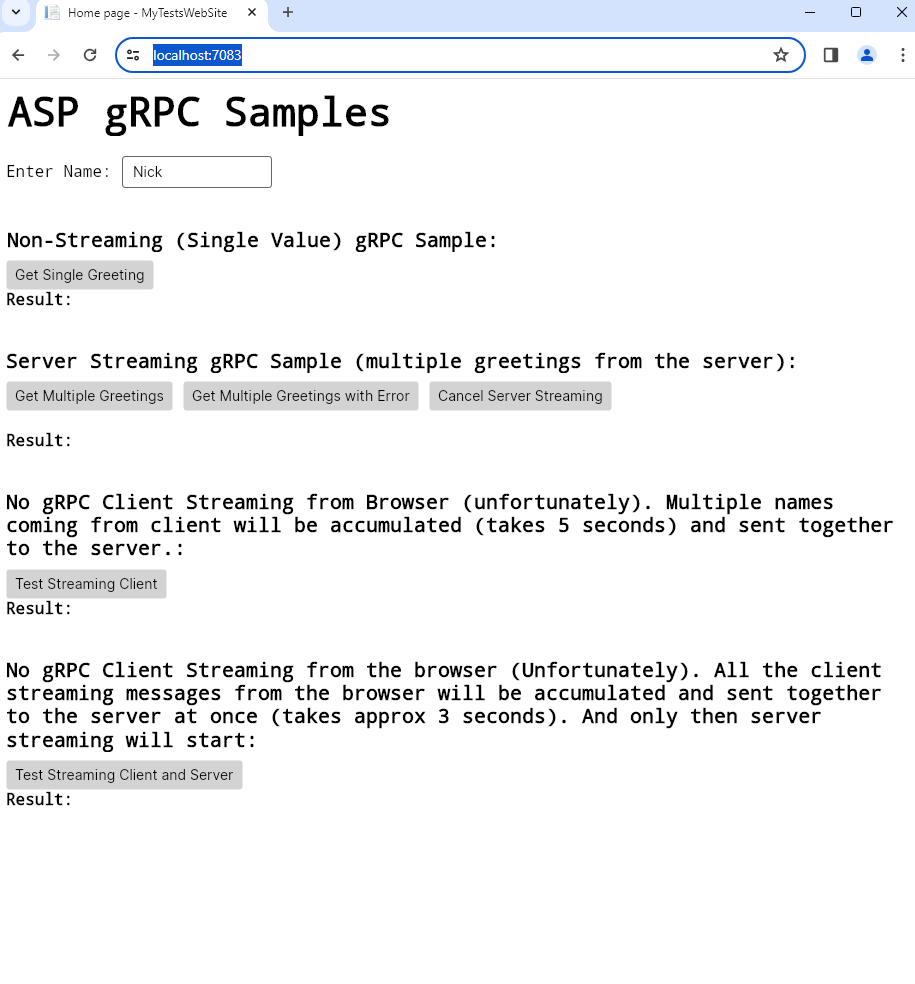
The upper two samples (request/reply and server samples) will behave almost exactly the same as those of the previous section:
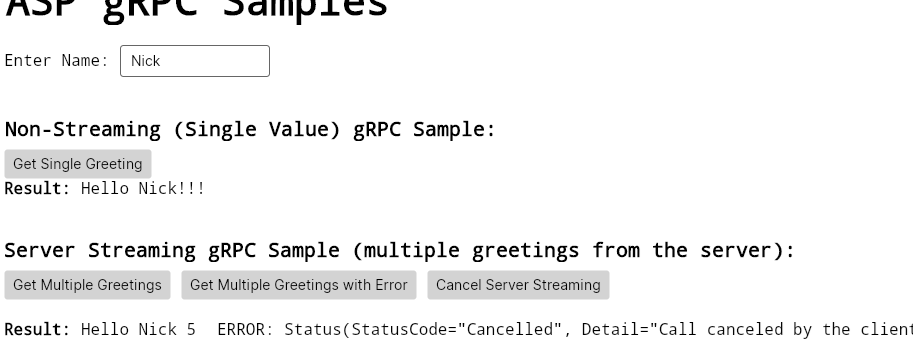
The two bottom samples correspond to Client streaming and bi-directional client-server streaming and the purpose is to show that they will NOT work correctly in browser.
Indeed, if you press "Test Streaming Client" or "Test Streaming Client and Server" buttons, the server will get the messages and start responding only when the client stream is completed (it is 5 seconds for Streaming Client sample and 3 second for bi-directional sample). Which essentially means that client streaming is not working (even though C# generates client proxies for those protobuf methods).
Creating Client C# Avalonia Projects
To create an Avalonia WebAssembly project I use instructions from Creating Avalonia Web Assembly Project :
- I install wasm-tools (or make sure they are installed) by running dotnet workload install wasm-tools from a command line.
- I update to the latest avalonia dotnet templates by running command: dotnet new install avalonia.templates
- I create a folder for the project (in my case it is called AvaGrpcClient) and cd to it using the command line.
- From within that folder, I run from the command line: dotnet new avalonia.xplat
- This will create the shared project AvaGrpcClient (within the same-named folder) and a number of platform specific projects.
- I remove most of the platform specific projects leaving only AvaGrpcClient.Browser (for building the Avalonia WebAssembly bundle) and AvaGrpcClient.Display (for debugging and faster prototyping if needed).
Client Avalonia Code
In order for the project AvaGrpcClient to generate the gRPC client proxies, I add a reference to the protobuf file to AvaGrpcClient.csproj file with GrpcServices flag set to Client:
I also add references to packages required by Grpc including Grpc.Net.Client.Web package needed specifically for the grpc to work in a browser:
Almost all Sample specific client code is located within MainView.xaml.cs and MainView.xaml files. MainView.xaml specifies the visual layout while all the code interacting with the server is inside MainView.xaml.cs file.
The connection to the client is established within MainView class constructor:
Note the CommonData.Url static string property. It should contain the URL for connected to the Grpc calls ( nn my case it is the same as ASP.NET server URL).
This CommonData.Url property is set to the first argument passed to the Program.Main(...) method contained in AvaGrpcClient.Browser solution (solution that actually creates WebAssembly browser code as a number of .wasm files):
Note also that calling the following code
essentially replaces an HTML element with id "out" by the Avalonia Browser application (in our case it is MainView object instance).
The callbacks fired when the corresponding buttons are pressed are defined as methods within MainView.xaml.cs file.
Here is the code for calling Single Request/Single Response (Unary) service SayHello from the client:
where GreetingName property is the Text value from the TextBox defined in MainView.xaml file:
Here is the documented client code for testing server streaming:
Code for testing server streaming with error is exactly the same, only calls a different service ServerStreamHelloRepliesWithError(...) :
The method below cancels server streaming from the client
The next method demonstrates using the Client Streaming API. Because we work in C#, the Client Streaming API has been generated, and can be used - but, unfortunately it does not do the streaming from the browser. It waits until the client streaming is finished and then sends all the accumulated messages together:
And here is the code demonstrating bi-directional (client and server) streaming API suffering from the same problem (there is no Client side streaming from the browser - the browser accumulates client messages and sends the all together one the client closes the 'stream'):
ASP.NET Server Code
The server ASP.NET code is located within AspGrpcServer project.
There are two things to know about the project:
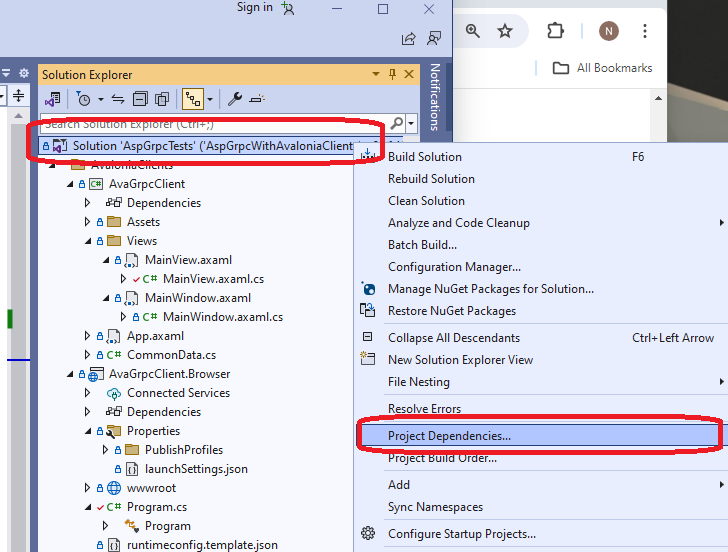
- There is a post-build event defined within the AspGrpcServer project (see the bottom of AspGrpcServer.csproj file). This event copies AppBundle/_framework folder created by AvaGrpcClient.Browser build over to AspGrpcServer/wwwroot/_framework folder. Note - this folder (_framework) should be ignored by the version control tool.
I modified the Shared/_Layout.cshtml code to be simpler and also I modified the Index.cshtml file to contain a <div id="out"> which will be replaced by Avalonia WebAssembly MainView object instance (as was explained above).
Here is the code for Index.cshtml:
On the last line of the above code - note that we are loading mainForAvalonia.js module. This module/file contains the JavaScript code that actually creates the Wasm and runs the wasm project in the browser.
Here is the JavaScript code contained inside mainForAvalonia.js file:
Note the last line - this is where we we pass the current server URL to server also as the URL for creating gRPC client communication channel.
Now take a look at the server's start-up file AspGrpcServer/Program.cs. The difference from a similar file from the previous (HTML/JavaScript) sample is very small. The only difference is that we need to add Mime types to allow returning .wasm and some other files to the client. Here is how it is achieved:
We create build a FileExtensionContentTypeProvider object inserting needed new MIME types into it and then we pass it as ContentTypeProvider property of StaticFileOptions object to the app.UseStaticFiles(...) method.
This is an article in which I provide easy samples and detailed explanations of all the use-cases for gRCP communications between various clients (including C# Console, HTML/JavaScritp and C# in Browser via WebAssembly clients), and gRPC-enabled ASP.NET server.
This article, along with any associated source code and files, is licensed under The MIT License

Comments and Discussions
Use Ctrl+Left/Right to switch messages, Ctrl+Up/Down to switch threads, Ctrl+Shift+Left/Right to switch pages.

COMMENTS
Dedication for Dissertation/Thesis: Example #1. I dedicate my dissertation work to my family and many friends. A special feeling of gratitude to my loving parents, William and Louise Johnson whose words of encouragement and push for tenacity ring in my ears. My sisters Katie, Linda and Rhonda have never left my side and are very special.
Below are some examples and guidance for writing a meaningful dedication in your dissertation. Example 1: "To my beloved parents, Your unwavering love, endless support, and sacrifices have been the cornerstone of my academic journey. Your encouragement and belief in my abilities have been my guiding light through the highs and lows of this ...
Book dedication examples to a friend. This book is dedicated to Tim. Thanks for encouraging me to write it. I dedicate this book to my friend and confidante, Jack Millhouse. He was the first person to encourage me to try. To Melissa R., for being a dedicated reader through all those rounds of revision. This one is for you.
DEDICATION I dedicate my dissertation work to my family and many friends. A special feeling of gratitude to my loving parents, William and Louise Johnson whose words of encouragement and push for tenacity ring in my ears. My sisters Katie, Linda and Rhonda have never left my side and are very special.
The acknowledgements section is your opportunity to thank those who have helped and supported you personally and professionally during your thesis or dissertation process. Thesis or dissertation acknowledgements appear between your title page and abstract and should be no longer than one page. In your acknowledgements, it's okay to use a more ...
Dedication, Acknowledgements, and Preface sections are all optional pages. But, what is the difference between these three? Dedication — A personal tribute to someone or a group of people. Example: "To my parents." Acknowledgements — A professional tribute to a person or people who helped you with the thesis. Example: "I wish to thank my thesis advisor for the hours of help in the lab ...
The Dedication Page is optional. If you choose to include a Dedication Page, please ensure that: You are using the same font as in the rest of your manuscript. No images are included. Page number ii appears centered at the bottom of the page. Please note that the Dedication Page is different from the Acknowledgements Page.
Examples of Dedications Take a look at our dedication examples to help you write a meaningful dedication, whether you are drafting the perfect dedication for a book or a thesis. Front Matter: What it is and Why it is Important All the material that appears at the front of a book before the actual content is called front matter, and it actually ...
Dissertation Acknowledgements: Examples and Writing Tips. ... Dissertation Dedication. In my case I used a dedication page to acknowledge someone who inspired me beginning when I was five years old, to pursue a doctorate. This allowed me to provide a special honor while including a wider range of individuals in my dissertation acknowledgement.
Here are some good examples to help you get started: Example 1. I couldn't have reached this goal without the help of many people in my life. I'd like to take this opportunity to thank them for their support. First, my sincere thanks to my dissertation committee. The value of their guidance cannot be overstated. Dr.
limit the abstract to one typed page; (b) maintain the scholarly language used throughout the. dissertation; (c) keep the abstract concise, accurate, and readable; (d) use correct English; (e) ensure each sentence adds value to the reader's understanding of the research; and (f) use the full.
The dedication page is separate from the acknowledgments page. If included, the dedi-cation text should be centered between the left and right margins and between the top and bottom margins; it should also reflect a professional nature. Do not include the title "DEDICATION" on the dedication page. 5. Table of Contents
Here are a few dedication examples to inspire you, categorized by the individuals you might choose to acknowledge: 1. Dedication to a Single Person: To my beloved spouse, [partner's name], thank you for your unwavering love, support, and encouragement throughout this entire process. Your patience and understanding during countless late nights ...
Example 2. I would like to thank my supervisors Dr. XXX and Dr. XXX for all their help and advice with this PhD. I would also like to thank my sisters, whom without this would have not been possible. I also appreciate all the support I received from the rest of my family. Lastly, I would like to thank the XXX for the studentship that allowed me ...
The other seven had an average of 23 words each. The dissertation dedications pages were brief and usually centered on a spouse, family members, or sometimes an influential mentor. You can find dissertation dedication page examples from your school or advisor in Proquest Digital Dissertations. Information and ideas for writing your dissertation ...
The significance of dedications in dissertations; Guidance on how to write them effectively; Different types of dedications with examples; By understanding these aspects, you will be able to create a powerful dedication that adds value to your dissertation and resonates with your readers. Types of Dedication in a Dissertation 1. Informal Dedication
DEDICATION This dissertation is dedicated to all of my former students in Detroit. Although you called me teacher, I was the one who was learning. Thank you! I also dedicate this work to my mother and father, Joyce and Jim Stockdill, who first taught me the value of education and critical thought.
To my mother-in-law, Maryam, known only briefly but loved and missed, who represented to me 'living proof' of Black women's ability to redefine and recreate our lives despite, and maybe even because of, the tremendously constraining, oppressive and repressive situations in which we often exist. To my dear husband, Bala who remains willing ...
Dedication This dissertation is lovingly dedicated to my mother, Catherine Hawes Coleman Seaman, Ph. D. Her support, encouragement, and constant love have sustained me throughout my life. Acknowledgements I am most grateful to the members of my committee, Dr. Robert
Dedication Page 4. Title Page 5. Acknowledgments 6. Abstract 7. Table of Contents 8. List of Figures 9. List of Tables ... THE OFFICE OF GRADUATE EDUCATION SAMPLE PAGES: DISSERTATIONS AND THESES (2 double line spaces) by (2 double line spaces) JOHN SMITH, BS, MS (5 single line spaces) DISSERTATION (or THESIS)
A dissertation is a long-form piece of academic writing based on original research conducted by you. It is usually submitted as the final step in order to finish a PhD program. Your dissertation is probably the longest piece of writing you've ever completed. It requires solid research, writing, and analysis skills, and it can be intimidating ...
Dedication This thesis work is dedicated to my husband, Bruce, who has been a constant source of support and encouragement during the challenges of graduate ... William and Karen Ryan, who have always loved me unconditionally and whose good examples have taught me to work hard for the things that I aspire to achieve. iii Curriculum Vitae ...
A dissertation is a comprehensive research project often pursued at the postgraduate level. It involves extensive study, analysis, and original contributions to a specific field. Dissertations showcase a student's ability to conduct independent research, critically evaluate literature, and communicate complex ideas effectively.
Download sample code; Web gRPC Under ASP.NET 8.0, Kestrel with HTML/JavaScript and Avalonia Clients. Dedication. This dedication is my farewell present to my good friends at Kahua.com including. Colin Whitlock - who on top of being a great CTO, is also a great manager, architect and developer in the company.; Jon Sinsel - an extremely sharp C# guru who very patiently introduced me to Uno ...